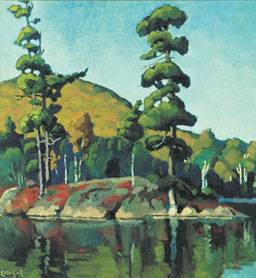Holgate show at MMFA
Lush nudes and landscapes

Blackberry Island, Lac Tremblant (about 1934), by Edwin Holgate
Source: Montreal Museum of Fine Arts
Art History Professor Brian Foss is the co-curator of a major retrospective at the Montreal Museum of Fine Arts this summer of 165 works by Montreal painter Edwin Holgate (1892-1977), perhaps one of Canada’s most underappreciated artists.
Foss is a specialist in Canadian art of Holgate’s period, but even he didn’t fully appreciate the artist’s range, which includes vigorous landscapes as well as the marvellous nudes and portraits for which he’s better known.
“The same pieces are reproduced over and over,” Foss said. “People don’t realize his work was so broad.” Holgate loved the landscape of Quebec, and he was a master of wood engraving.
In the 1920s and 1930s, some of Canada’s finest talents in portraiture and figure painting were working in Montreal, and Holgate was at the centre of this circle. Unusually for an anglophone of the time, he was equally at home in the French-speaking art world of the city.
Printing master
Impressed by the revival of wood engraving in Europe, he began making woodblock prints in the early 1920s. This interest led him to create book illustrations for a number of Quebec writers. Many of his prints were exhibited at the Canadian Society of Graphic Art, of which he was a founding member.
His association with the Group of Seven began through his friendship with A.Y. Jackson, who in 1926 invited Holgate to accompany him on a month-long trip to the Skeena River in British Columbia.
Holgate painted scenes of the Northwest coast landscape, portraits of the Skeena River people and views of their villages. The Group of Seven especially admired Holgate’s portraits and paintings of nude figures, and in 1929 he was invited to join the Group of Seven as their eighth member.
Holgate enlisted in both World Wars and filled his sketchbooks with scenes from the front lines. In World War II he acted as an official war artist for the Canadian government, sketching the daily activities of the pilots and officers at two Royal Canadian Air Force stations in England.
When he came home to Montreal after the war, figurative painting was out and abstract expressionism was in. Holgate decided to withdraw from the urban bustle and moved to Morin Heights in the Laurentians north of Montreal, where he continued to paint.
Group of Seven
In the 1960s, as respect for the Group of Seven’s work grew, Holgate was included in the recognition of the Group’s contribution to Canadian art. He died in 1977 at the age of 84.
As The Gazette’s art critic, Henry Lehman, remarked on June 4, the fact that Holgate’s work is being shown now at the MMFA is “a declaration of his move up into the realm of modernism, a designation that denotes a form of artistic sainthood.”
Foss and his co-curator, Rosalind Pepall, have brought these works together for the first time since the artist’s death.
After Montreal, the exhibition will travel to the Glenbow Museum in Alberta, the McMichael Canadian Art Collection near Toronto, the National Gallery of Canada in Ottawa and the Beaverbrook Art Gallery in Fredericton, N.B.
A selection of works from the exhibit can be viewed on the Montreal Museum of Fine Arts website. You can find it at www.mmfa.qc.ca.